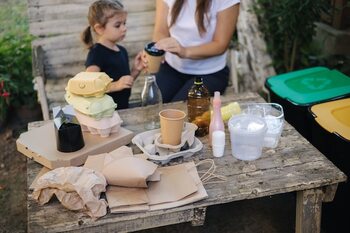Create a home that fosters collaboration and family learning.

Create a home that fosters collaboration and family learning. In a world where connection is vital, transforming your home into a space that encourages teamwork and continuous learning is essential. This article will guide you through key practices and elements to design environments that not only strengthen family bonds but also inspire curiosity and intellectual growth. Discover how every corner of your house can be a catalyst for enriching shared experiences.
The importance of open design to foster interaction
Open design in the home is an effective strategy to encourage interaction and a sense of community among family members. By eliminating physical barriers, such as walls and doors, a natural flow is created that invites people to move freely through the spaces. This environment fosters spontaneous conversations and joint activities, as everyone can see and hear each other easily. Additionally, an open design allows natural light to flow unobstructed, which contributes to creating a more inviting and warm space where families can enjoy shared moments.
The arrangement of furniture also plays a crucial role in this type of design. By opting for modular furniture or groupings that encourage closeness, collaboration and learning among household members can be further facilitated. For example, an open kitchen to the living room not only allows the person cooking to participate in family conversations, but also turns this space into the center of creative activities such as cooking together or doing homework. In this way, the home transforms into a dynamic environment where every corner can be utilized to cultivate meaningful relationships and stimulate joint learning.
2. Multifunctional spaces: creativity and versatility in action
Multifunctional spaces are an ideal solution for creating a home that fosters collaboration and family learning. By designing areas that can adapt to different activities, such as work, study, or play, a dynamic and flexible environment is promoted. For example, a living room can transform into an impromptu classroom during the day and into a family cinema at night. This type of versatility not only optimizes the use of space but also encourages interaction among family members, allowing everyone to actively participate in the various activities taking place.
Creativity plays an essential role in the creation of these multifunctional spaces. Incorporating modular furniture or decorative elements that serve multiple purposes can help maximize both space and functionality. For example, folding tables or wheeled shelves can facilitate a quick reconfiguration of the environment according to the moment's needs. Additionally, involving the whole family in this design and adaptation process strengthens not only family cohesion but also the sense of belonging and shared responsibility towards their home. In this way, every corner becomes an opportunity to learn together and collaborate on creative projects.
3. Incorporating educational technology at home
The incorporation of educational technology at home can be a powerful tool to foster collaboration and family learning. Interactive platforms, educational apps, and smart devices can transform any room into a dynamic classroom where family members can explore new skills and knowledge together. For example, using tablets with learning programs for the whole family can turn study sessions into collaborative activities, where each person contributes their perspective and experience. This integration not only makes the learning process more fun and engaging but also strengthens family bonds by sharing educational achievements.
Moreover, creating an inclusive technological environment invites curiosity and self-exploration. Spaces designed to facilitate access to digital resources, such as a virtual library or workstations equipped with educational tools, allow each family member to learn at their own pace while supporting each other. Activities like online educational games or multimedia projects can be excellent ways to bring everyone together around common goals. By integrating these technologies into your home, you are not only enhancing educational opportunities but also creating meaningful moments that reinforce the values of teamwork and shared discovery.
4. Family activities: games that teach and bring together
Family activities are an excellent way to bring all members of the household together, and educational games are especially valuable. By choosing games that combine fun with learning, not only is teamwork encouraged, but opportunities are also created for each family member to share their knowledge and skills. From board games that reinforce math and vocabulary to outdoor activities that stimulate problem-solving, these experiences can be both educational and entertaining. The key is to select games that suit the ages and interests of all participants, thus ensuring active participation and collective enjoyment.
In addition to being an endless source of fun, these games allow for meaningful moments of family interaction. Through play, parents can teach valuable lessons about empathy, patience, and respect for turns, while children have the opportunity to practice social skills in a safe and loving environment. Creating a "play corner" at home can be a great step toward this goal; a dedicated space where regular sessions for playing together can be organized. This way, you will not only strengthen family bonds but also cultivate an environment conducive to continuous learning and personal development for each of its members.
5. The influence of color on learning and collaboration
Color has significant power in our psychology and can influence our mood, creativity, and ability to concentrate. In a home designed to foster collaboration and learning, choosing the right palette can make a big difference. For example, shades of blue and green tend to be calming and can help create an environment conducive to study, while warmer colors like yellow or orange can stimulate communication and social interaction. When painting walls or selecting decorative accessories, it's essential to consider how each color can affect family dynamics and the approach to learning.
In addition to the walls, shared workspaces should be designed with attention to color. An area intended for family projects or study sessions can benefit from details that encourage collaboration; for example, using whiteboards or cork boards painted in vibrant colors can inspire creativity and innovation. Incorporating decorative elements that represent family achievements or educational goals can also serve as visual motivation. By integrating these chromatic aspects into your home, not only is an attractive environment created, but an atmosphere is established where curiosity flourishes and collaboration becomes an integral part of daily family life.
6. Creating reading nooks: nurturing curiosity together
Creating reading nooks in your home is an effective way to nurture curiosity and a love of learning within the family. By designating specific spaces for reading, such as a cozy corner with cushions, blankets, and shelves filled with a variety of books, all household members are invited to immerse themselves in new stories and knowledge. These spaces should not only be comfortable but can also be decorated with elements that inspire creativity, such as illustrations or thematic maps related to the available books. This way, every time someone sits down to read, an environment conducive to reflection and dialogue about what has been learned is generated.
In addition to the physical aspects of the reading nook, it is equally important to encourage shared activities in this space. Organizing family reading sessions where each person shares their impressions about a specific book or topic can be an enriching activity that promotes communication and critical analysis. You can also introduce literary games or debates about read stories that stimulate active participation and collaboration among all family members. Thus, by transforming these nooks into centers of joint exploration, not only is the family bond strengthened, but a seed of intellectual curiosity is also sown that will flourish throughout life.
7. Cooking with family: a recipe to learn and enjoy
Cooking with family is one of the most rewarding and educational activities that can be enjoyed together. It's not just about preparing food, but about creating shared moments where each member can contribute their personal touch to the recipe. From selecting the ingredients to deciding how to present the final dish, every step is an opportunity to learn about nutrition, math when measuring, and practical skills like organization and cleaning. Additionally, cooking in a group encourages communication and teamwork, as everyone must coordinate to achieve the desired result.
The kitchen thus becomes a dynamic classroom where lessons transcend the culinary. By involving children in this activity, we teach them valuable life skills while strengthening family bonds. The experience of cooking together also helps cultivate patience and creativity; moreover, it is an ideal space to share family stories and traditions that enrich our cultural identity. So take those cooking utensils out of the cupboard and become the master chef of your home: a successful recipe is just a few steps away!
8. The power of art as a collaborative tool
Art has a transformative power that goes beyond aesthetics; it becomes a fundamental collaborative tool within the home. By integrating artistic activities into family life, an environment is fostered where each member can express themselves freely and contribute to a common project. Whether through painting, drawing, or even sculpture, these shared experiences allow families to explore their collective creativity, thus strengthening their bonds while learning to work together towards a goal. Furthermore, the creative process invites dialogue and reflection, making each artistic session an opportunity to share unique ideas and perspectives.
Incorporating art also allows children to develop important skills such as problem-solving and critical thinking. When they work on a joint piece, they must collaborate to make decisions about colors, shapes, and techniques, which is not only fun but enriching. Likewise, the space designated for these activities can be designed with inspiring and functional elements that motivate the constant exploration of learning. In this sense, art becomes a vehicle not only for expressing individual emotions and thoughts but also for fostering a spirit of cooperation that will endure in family dynamics in the long term.
9. Establishing family routines that promote continuous learning
Establishing family routines that promote continuous learning is an effective strategy to cultivate an enriching environment at home. These routines can include specific moments dedicated to reading, discussing topics of interest, or even practical activities like scientific experiments and art projects. By allocating regular time for these activities, not only individual learning is encouraged, but also collaboration among family members. Creating a space where everyone feels comfortable sharing their ideas and knowledge strengthens family bonds and allows each person to contribute their unique perspective.
Incorporating playful elements into educational routines can make learning even more engaging. For example, organizing themed nights where different cultures or sciences are explored through games and interactive dynamics can spark the natural curiosity of both children and adults. Additionally, involving each member in the planning of these activities ensures that everyone has a voice and a vote, which increases their commitment and interest. Ultimately, establishing these routines not only enriches family knowledge but also creates lasting memories and reinforces a shared sense of purpose and collaboration.



